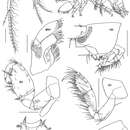Comprehensive Description
provided by Smithsonian Contributions to Zoology
Gammaropsis atlantica Stebbing
Gammaropsis atlantica Stebbing, 1888, p. 1101, pl. 114.
Gammaropsis zeylanicus Walker, 1904, pp. 282–283, pl. 6, fig. 41; 1909, p. 339.
Gammaropsis Gardineri Walker, 1905, pp. 929–930, pl. 88 figs. 11–14, 16, 17.
Eurystheus atlanticus.—Stebbing, 1906, p. 611; 1908, pp. 86–87, pl. 40B.—Tattersall, 1922, pp. 10–11, pl. 1, figs. 17–20.—K. H. Barnard, 1937, p. 164.—Pillai, 1957, pp. 56–57, fig. 14.—J. L. Barnard, 1965a, pp. 534–535, fig. 29.
DIAGNOSIS OF MALE FORM A.—Lateral cephalic lobes projecting to medium extent, eye Iagenifonn in juveniles and adults from 1.8 to 4.5 mm in body length, juveniles of 1.2 mm with vertically oriented ovate eye lacking dorsoposteriorly extended ommatidia; accessory flagellum thin and 6-articulate in adults; gnathopod 2 with palmar axis oblique, large palmar concavity near defining corner, with large spine on medial surface near concavity, palmar bulge near finger hinge forming 3 low humps each minutely undulate, palmar defining corner scarcely produced, dactyl slightly shorter than palm, article 6 of gnathopod 2 about 1.5 times as long as broad; terminal male with heavy setation on anteromedial margins of articles 2 and 6.
FEMALE.—Gnathopod 2 fully developed as in Figure 112f, with crenulate palm and slight process at defining corner. Juveniles lacking process at corner.
COLOR IN 2-DAY FORMALDEHYDE.—Eyes red or orange, head purple or white but bleaching white in alcohol.
DIAGNOSIS OF MALE FORM B.—Lateral cephalic lobes projecting very strongly, coniform, eyes in youthful members (3.1 mm) ovate horizontally and confined to ocular lobe, in terminal adults ommatidia proliferating in dorsoposterior direction toward forehead and eye becoming lageniform; accessory flagellum thick and not exceeding 4 articles; gnathopod 2 with palm less oblique than form A, concavity shallower and narrower but defining cusp much larger, palmar bulge with 1 or 2 humps only, articles 2 and 6 with very few setae.
FEMALE.—Frequently maintaining juvenile gnathopod 2 into old age (4.0 mm), but accessory flagellum slender and often 5-articulate.
COLOR.—Same as form A but majority of specimens maintaining purple-pink head and anterior body stain in alcohol.
MATERIAL.—JLB Hawaii 2 (14), 3 (23), 5 (6), 6 (10), 8 (1), 10 (20), 12 (4), 13 (18). Makapuu Point, Oahu, April 1967, Zoanthus (1), collectors Ralph Bowers and Dr. Jerry Welch.
- bibliographic citation
- Barnard, J. L. 1970. "Sublittoral Gammaridea (Amphipoda) of the Hawaiian Islands." Smithsonian Contributions to Zoology. 1-286. https://doi.org/10.5479/si.00810282.34

